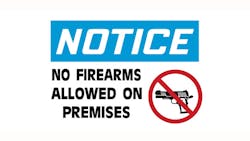Practical Preparedness for Workplace Violence, Part 4: Top 10 Action Steps
During his presentation at an April 9 workplace violence seminar in Cleveland, Brent O’Bryan, SPHR, vice president of learning and development at Allied Barton Security Services, outlined 10 clear action steps employers can take to address and prevent workplace violence.
O’Bryan, whose presentation stressed the importance of establishing a workplace violence policy and creating a threat assessment team to address potential workplace violence signs, offered the following 10 action steps for workplace violence prevention:
1. Conduct background screening for all new employees. At the minimum, O’Bryan recommends criminal background checks for new hires. Some employers may wish to conduct more comprehensive background checks, as well.
2. Watch for the warning signs and quiet calls for help. “If left unchecked, [the situation] could escalate,” O’Bryan said. Read about the warning signs in Part 1 of this series.
3. Plan in advance for workplace violence as you would for any other threat to your business. O’Bryan acknowledged that no employer likes to imagine a violent incident will occur on work property, but employers must be prepared to respond to such situations. “You make sure there’s a plan in place for any technical shutdown to the company, such as [implementing] storm protection, and you need to make plans for this as well,” he said.
4. Proactively work with employees to help solve workplace issues. If an interpersonal issue emerges in your work force, someone in a leadership role should help guide the situation to a positive resolution.
5. Step in when warning signs are present. Some leaders might feel uncomfortable addressing a difficult worker’s behavior or interfering in tense employee relationships, but ignoring that tension could allow the situation to escalate.
6. Deal with poor performers. Examining worker-on-worker violence reveals that these situations often stem from a poor performer, or a poor attitude in the workplace, that was never dealt with. Sometimes, O’Bryan said, having a discussion with the employee in question could be enough to help set things right. Other times, however, a pattern of bad behavior must be documented and the employer must take additional steps, such as formally disciplining or firing the worker.
7. Establish a wellness program. “Work is one of the primary stressors in people’s lives,” said O’Bryan. As stress rises, the likelihood of workplace violence occurring also may rise. Wellness programs can help address some of those stress issues.
8. Develop a positive and open workplace culture. A culture of openness encourages employees to share concerns with their coworkers rather than holding everything in and letting the frustration build.
9. Provide employees with appreciation and recognition. Recognition can create a more positive work environment, reduce stress and improve workplace culture. Employees who regularly do not receive such recognition, meanwhile, will be made aware that their work or attitudes are not up to the standard of others.
10. Provide consistent employee training surrounding workplace violence. “Train everyone,” O’Bryan said, “and train them more than once.” He stressed the importance of using real scenarios and examples during training, such as holding evacuation drills to help employees understand how to safely respond in the event of a workplace violence incident. While some employers may be uncomfortable with this step, he said that such hands-on training is more effective.
During his presentation, O’Bryan cited a 2010 survey that revealed 70 percent of workplaces do not have a formal workplace violence prevention policy or program in place. “I hope that statistic improves,” he said. “You need a policy to address this issue proactively.”
This is an installment in a special series on workplace violence prevention. Access all parts here:
About the Author

Laura Walter
Laura Walter was formerly senior editor of EHS Today. She is a subject matter expert in EHS compliance and government issues and has covered a variety of topics relating to occupational safety and health. Her writing has earned awards from the American Society of Business Publication Editors (ASBPE), the Trade Association Business Publications International (TABPI) and APEX Awards for Publication Excellence. Her debut novel, Body of Stars (Dutton) was published in 2021.
